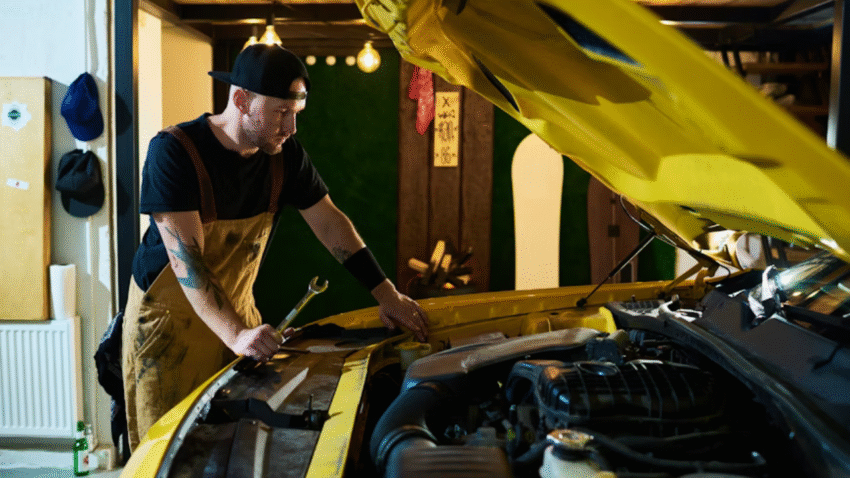Introduction
A dull, stained garage floor can make your entire workspace look worn out. Applying an epoxy coating not only transforms the look of your garage but also creates a durable, easy-to-clean surface that can withstand vehicles, tools, and heavy foot traffic. Learning how to epoxy coat your garage floor step-by-step will help you achieve a professional-grade finish that lasts for years.
Why Epoxy Coating Matters for Your Garage Floor
Epoxy coating isn’t just about aesthetics—it offers multiple benefits:
- Durability: Resistant to chemicals, stains, and abrasions.
- Easy maintenance: Spills wipe up easily, and dust won’t stick as much as on bare concrete.
- Improved safety: Non-slip additives can be mixed in to prevent accidents.
- Boosted home value: A polished garage floor is a selling point for buyers.
Whether you’re upgrading your personal workshop or preparing your home for sale, epoxy coating is one of the best long-term improvements you can make to your garage.
Step-by-Step Guide to Epoxy Coating Your Garage Floor
1. Choose the Right Epoxy Kit
Epoxy coatings come in water-based, solvent-based, and 100% solids formulas:
- Water-based: Easiest to apply, great for DIYers.
- Solvent-based: More durable but requires good ventilation.
- 100% solids: Thickest and most durable, but also the most challenging to work with.
Look for a kit that includes both the epoxy resin and hardener, along with optional color flakes for a decorative finish.
Pro Tip: If your garage is larger than a single kit covers, buy all your kits at once to ensure consistent color.
2. Gather Tools and Materials
You’ll need:
- Epoxy floor coating kit
- Concrete cleaner or degreaser
- Etching solution (often included in kits)
- Pressure washer or stiff broom
- Paint roller with extension pole
- Paint brushes for edges
- Mixing bucket and drill with mixing paddle
- Painter’s tape
- Safety gear: gloves, respirator mask, safety glasses
3. Prepare the Garage Floor
Clear the Area
Remove all items from the garage, including shelving or equipment.
Clean Thoroughly
Sweep and vacuum to remove dirt and debris. Clean oil spots with a degreaser to ensure proper adhesion.
Repair Cracks
Fill any cracks or holes with a concrete patch compound and allow to dry completely.
Etch the Concrete
Etching opens the pores of the concrete so the epoxy can bond properly. Apply etching solution evenly, scrub with a stiff broom, then rinse thoroughly with a pressure washer or hose. Let the floor dry completely—this may take 24–48 hours.
Safety Note: Wear gloves and eye protection during etching.
4. Protect Walls and Edges
Use painter’s tape along the bottom of walls and around door frames to keep epoxy from spreading where it shouldn’t.
5. Mix the Epoxy
Follow the manufacturer’s instructions exactly. Typically:
- Pour the resin and hardener into a mixing bucket.
- Use a mixing paddle to blend for 2–3 minutes.
- If using color flakes, keep them separate until after you’ve applied the base coat.
Pro Tip: Once mixed, epoxy has a limited working time—usually 30–45 minutes—so plan your application in sections.
6. Apply the Epoxy Base Coat
- Cut in edges with a paintbrush around walls and corners.
- Use a roller with an extension pole to apply epoxy in 4×4 foot sections, working from the back of the garage toward the door.
- Maintain a wet edge to avoid lap marks.
7. Broadcast Color Flakes (Optional)
While the base coat is still wet, sprinkle color flakes evenly across the surface. This adds texture and helps hide imperfections.
Pro Tip: Toss flakes upward and let them fall like confetti for even coverage.
8. Apply the Second Coat or Topcoat
If your kit requires a second coat or clear topcoat:
- Allow the first coat to cure as directed (often 12–24 hours).
- Lightly sand any rough spots before applying the second layer.
- Roll on the topcoat for added protection and a glossy finish.
9. Allow to Cure Fully
Epoxy takes time to fully harden:
- Light foot traffic: 24 hours
- Vehicle traffic: 72 hours or more
Keep the garage closed during curing to avoid dust and debris settling on the surface.
Common Mistakes to Avoid
- Mistake: Skipping floor preparation.
Solution: Cleaning, repairing, and etching are essential for adhesion. - Mistake: Applying epoxy to damp concrete.
Solution: Ensure the floor is completely dry before starting. - Mistake: Mixing too much epoxy at once.
Solution: Mix only what you can apply within the working time. - Mistake: Ignoring temperature and humidity recommendations.
Solution: Follow the manufacturer’s environmental guidelines for best results. - Mistake: Walking or driving on the floor too soon.
Solution: Allow full curing time to avoid damage.
Extra Garage Tips & Hacks
- Add Non-Slip Additives: If you live in a wet or snowy climate, mix anti-slip grit into your topcoat for safety.
- Maintain Your Floor: Clean with a mild detergent and avoid harsh chemicals to preserve the finish.
- Recoat When Needed: With proper care, epoxy floors can last 10+ years before recoating.
For surface preparation tips, see our guide on How to Repair Cracked Garage Floor Concrete before starting your epoxy project.
Conclusion
Epoxy coating your garage floor is one of the most impactful upgrades you can make for durability, appearance, and ease of maintenance. By preparing the surface properly, applying the epoxy carefully, and allowing it to cure fully, you can achieve a flawless, long-lasting finish.
Final Tip: Take your time with preparation—80% of a professional-looking job is in the prep work.
CTA: Bookmark this guide and use it as your step-by-step reference for transforming your garage floor into a durable, high-gloss surface.
